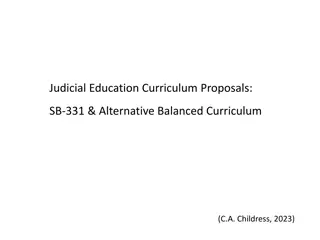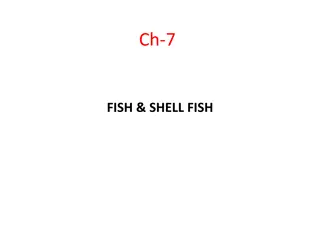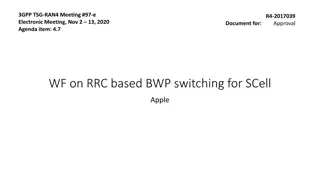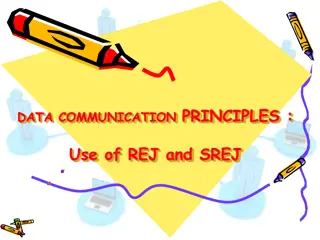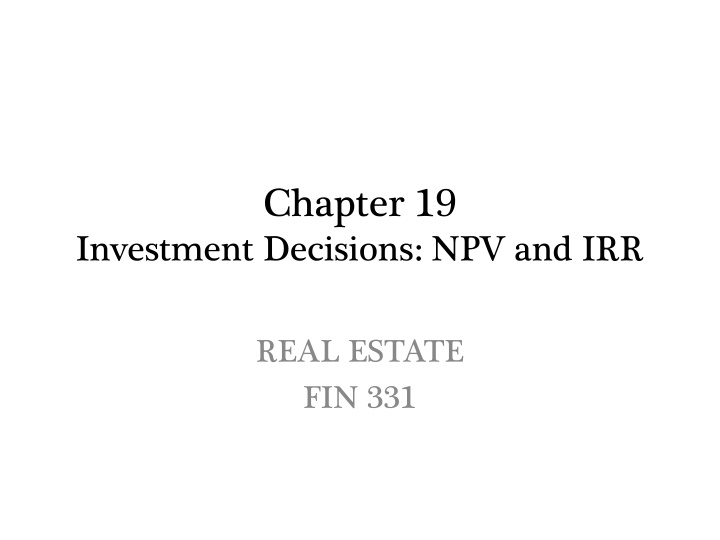
Investment Decisions: NPV and IRR in Real Estate
Explore how Net Present Value (NPV) and Internal Rate of Return (IRR) guide investment decisions in real estate, highlighting the importance of multi-year analysis and leverage impact. Learn how to use single-year return measures and understand the limitations of such methods.
Uploaded on | 1 Views
Download Presentation

Please find below an Image/Link to download the presentation.
The content on the website is provided AS IS for your information and personal use only. It may not be sold, licensed, or shared on other websites without obtaining consent from the author. If you encounter any issues during the download, it is possible that the publisher has removed the file from their server.
You are allowed to download the files provided on this website for personal or commercial use, subject to the condition that they are used lawfully. All files are the property of their respective owners.
The content on the website is provided AS IS for your information and personal use only. It may not be sold, licensed, or shared on other websites without obtaining consent from the author.
E N D
Presentation Transcript
Chapter 19 Investment Decisions: NPV and IRR REAL ESTATE FIN 331
Overview A. Major theme: most RE decisions are made with an investment motive 1. magnitude of expected CFs--and the values they create are at the center of investment decision making B. Chapter 18 focuses on widely used, single- year, return measures, ratios, & income multipliers C. These criteria are relatively easy to calculate & understand an advantage in the eyes of many industry professionals
Overview D. Limitation of these single-year return measures & ratios? 1. They do not explicitly incorporate income producing ability of property beyond 1st year of rental operations 2. May lead to suboptimal investment decisions
Overview E. Many investors also perform multi-year analyses of potential acquisitions F. When using multi-year Discounted Cash Flow (DCF) decision making methods, investor must 1. Estimate how long she expects to hold property 2. Make explicit forecasts of: a. property s net CF for each year, b. net CF produced by expected sale of property 3. Select rate of return at which to discount all future CFs
Overview G. NPV decision rules 1. NPV = Present Value of ATCF minus the Initial Investment 2. If NPV is greater than 0, we make the investment 3. If NPV is less than 0, we will not make the investment H. Measuring the impact of leverage 1. Leverage involves the use of debt to finance part of the acquisition 2. The interest charges on debt will reduce our taxable income 3. Traditional analysis uses ATCF values to compute NPV I. Internal Rate of Return (IRR) 1. When NPVs are greater than 0, the internal rate of return will be greater than the discount rate used to compute NPV 2. if NPV is equal to 0, then the internal rate of return equals the discount rate 3. if NPV is less than 0, then the IRR is less than the discount rate
IRR Problem A. IRR & NPV will always give the same accept- reject signal for an individual investment B. But .. 1. IRR may rank investment opportunities differently than NPV a. NPV ranking is always always consistent with wealth maximization 2. IRR is subject to change of signs a. If projected CFs change signs more than once over expected holding period, there may be multiple IRRs
Centre Point: 5-Year Operating Pro Forma-Unlevered
Sale of Centre Point at End of 5thYear A. Assumptions 1. Annual market rent increases = 3% per year 2. Vacancy & Collection Losses = 10% per year 3. Operating Expenses = 40% of EGI 4. Capital Expenditures = 5% of EGI 5. Expected Holding Period = 5 years 6. Selling price based on Year 6 NOI a. NOI6= 103,291 (projected) b. Sale Price = 103,291 / 0.0875 =$ 1,180,469
Centre Point: Reversion Sale Price NOI 6 = , 1 $ 180 , 469 0875 . 0 103 $ , 291 = , 1 $ 180 , 469 0875 . 0
Centre Point Example Year Year 1 2 3 4 5 S SPV Annual BTCF Annual BTCF BTER BTER Total CF Total CF PV @ 14% PV @ 14% $29,028 31,701 34,454 37,290 $40,211 $29,028 31,701 34,454 37,290 $432,062 $25,463 $24,393 $23,255 $22,079 $224,399 $319,590 $391,851 $391,851 Sell Price Sell Price Sell Expense Sell Expense Net Proceeds Net Proceeds RMB Mortgage RMB Mortgage BTER BTER $1,180,469 47,219 1,133,250 741,399 $391,851 $391,851 <= NOI6 / 0.0875 $ PVin PVin $319,590 $319,590 PVout PVout NPV NPV $287,760 $287,760 $31,830 $31,830 Down Pmt Down Pmt Loan Fees Loan Fees Pvout $264,000 $23,760 $287,760 $287,760
Net Present Value of Centre Point NPV = PVin PVout PVoutin this example is equal to original equity investment of $287,760 NPV = $319,591 $287,760 Decision: Accept Centre Point investment opportunity because doing so will increase equity investor s wealth by $31,831
Selecting Discount Rates A. Discount rate is composed of two parts: E(Rj) = r = Rf+ RPj 1. 1. R Rf f is risk-free rate a.yield/return available on U.S. Treasury securities with maturity equal to the expected holding period of the property b. This benchmark rate is readily observable 2. 2. RP RPj jis risk premium for subject property a.This component of discount rate is difficult to determine
Measuring the Impact of Risk on NPV A. Sensitivity analysis 1. Most likely scenario 2. Worst-case scenario 3. Best-case scenario B. Value of computer 1. Excel spreadsheets 2. Specialized software such as ARGUS C. Monte Carlo simulation (using random probabilities to develop outcome distributions)
Selecting Discount Rates A.Since risk premiums vary, so do required yields 1. High quality, relatively safe RE investments: currently 6-8% required returns 2. Development: 15%-30% or more B. So how do investors determine required risk premiums (RP RPj js)? 1. Market comparables 2. Cost of capital: Debt, Equity (Oppt y Cost)
HOMEWORK ASSIGNMENT A. Key terms: before tax cash flows, after-tax cash flows, leverage, leverage cash flow, unleveraged cash flow B. Study questions: 2, 3, 5, 9, 11



